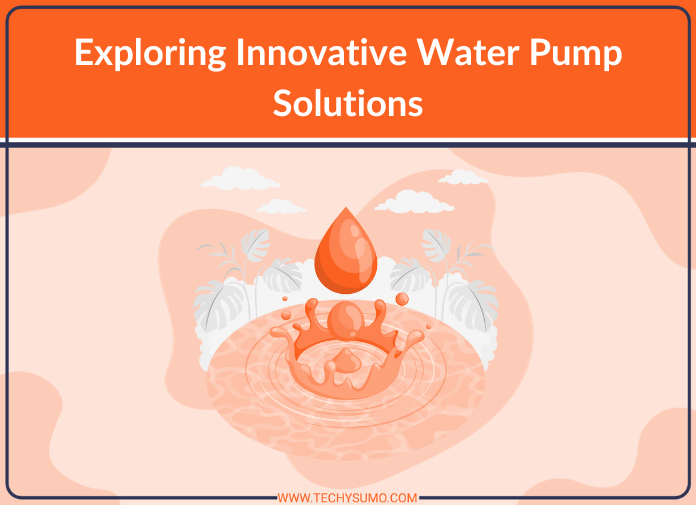Hydraulic pumps are the unsung heroes of our daily lives, silently working to ensure the uninterrupted flow of this vital resource. In today’s world, where access to clean water is paramount, the importance of modern water pump technology cannot be overstated. This article delves into different ideas of these pumps, unveiling the innovations that have revolutionized this essential equipment.
Table of Contents
What is Innovation in Water Pump?
Efficiency Redefined
Efficiency is the cornerstone of modern technology. These machines have come a long way from their humble beginnings, driven by human or animal power. Today, electric and solar-powered pumps dominate the landscape, offering unparalleled efficiency. These pumps can move water with precision, minimizing energy wastage.
The introduction of variable speed drives has further enhanced efficiency. VSDs allow pumps to adjust their speed based on demand, reducing energy consumption during periods of low water usage. This not only conserves energy but also extends the lifespan of the equipment.
Innovations in Design
Modern pumps have evolved not only in terms of functionality but also design. Compact and sleek, they take up less space and are easier to install. Submersible pumps, for example, can be submerged in water, eliminating the need for priming and ensuring a continuous water supply.
Furthermore, the use of corrosion-resistant materials has extended the durability of these pumps. This is particularly important in regions with harsh environmental conditions, where pumps are exposed to corrosive elements. Stainless steel and composite materials have become the materials of choice for many pump manufacturers.
Smart Technology Integration
The integration of innovative technology has transformed these pumps into brilliant systems. Remote monitoring and control have become standard features, allowing operators to keep a close eye on pump performance and make adjustments as needed. This not only saves time but also reduces maintenance costs.
Additionally, predictive maintenance algorithms have been incorporated into some water pump systems. These algorithms analyze data from various sensors to predict when maintenance is required, preventing unexpected breakdowns and costly repairs.
Energy-Efficient Motors

The heart of any hydraulic pump is its motor, and advancements in motor technology have had a significant impact on overall pump efficiency. High-efficiency motors, such as those meeting the IE3 and IE4 standards, are now widely used in the pump systems. These motors are designed to minimize energy loss through heat and friction, ensuring that the majority of the input energy is converted into valuable work.
Water Conservation
In today’s world, where water scarcity is a growing concern, these pumps are playing a crucial role in water conservation efforts. Variable speed drives, mentioned earlier, not only save energy but also allow for precise control of water flow. This means that water can be pumped precisely where and when it’s needed, reducing wastage.
In agriculture, for instance, precision irrigation systems use modern pumps to deliver the right amount of water to crops, optimizing growth and conserving water resources. These systems can even be programmed to adjust water delivery based on weather conditions and soil moisture levels.
Resilience and Reliability
The reliability of these pumps is vital, especially in critical applications such as municipal water supply and firefighting. Modern pumps are designed with redundancy in mind. Many systems incorporate multiple pumps operating in parallel, ensuring that there is always a backup in case of a failure.
Moreover, the use of advanced control systems allows for seamless transitions between pumps, minimizing disruptions in water supply. These failover mechanisms ensure that even in the face of adversity, water continues to flow to homes, businesses, and emergency services.
Environmental Considerations
Environmental concerns are at the forefront of modern pump technology. Manufacturers are increasingly focused on reducing the environmental impact of their products. This includes not only energy efficiency but also the use of eco-friendly materials and responsible manufacturing practices.
Furthermore, some pump systems are designed to minimize the risk of contamination. In applications where water quality is critical, pumps are equipped with features to prevent backflow and cross-contamination, ensuring that the water remains safe for consumption.
Conclusion
As we unveil the innovations in modern pump technology, it becomes evident that these machines have come a long way from their humble origins. Today’s pumps are efficient, innovative, and environmentally responsible. They play an important role in ensuring access to clean water, conserving resources, and supporting a wide range of applications, from agriculture to firefighting.
In a world where water is an increasingly precious commodity, the evolution of these pump technologies is a testament to human ingenuity and our commitment to sustainable living. These machines quietly perform their duty, ensuring that water continues to flow reliably and efficiently to meet our ever-growing needs.



